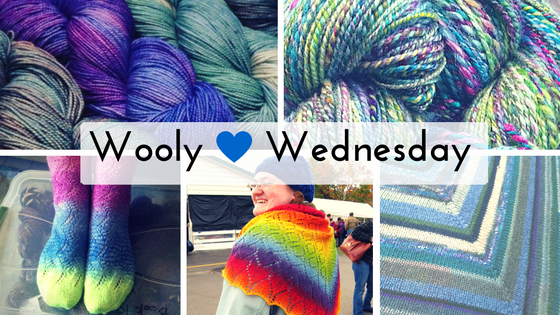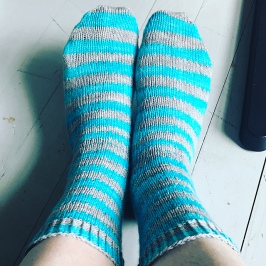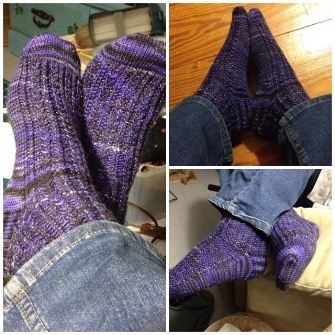
I read an article this week called 14 Things You Need to Get Started Knitting Socks, 
and it’s definitely got some good information in it, but I don’t really think you need fourteen things. Sure, a lot of those things are useful if you’re building a sock knitting kit, but you don’t need them all just to get started or give it a try. So I decided I’d give you my little low down on getting started with socks.
I avoided knitting socks for a long time because I’d heard that socks were Hard®! And I was scared away from them. But I’m here to tell you that if you can already knit in the round, you’ve got the hardest part conquered.
Okay so here’s what you really need: a set of sock needles, a tapestry needle for weaving in your ends, and some yarn. And I’ll talk a little bit more about each of these things now.
 Needles: There’s a lot of debate over what needles to use for your sock knitting. I’m a DPN girl, myself, but there are lots of other options. You can use a single circular needle for magic loop, two circulars, or even a tiny 9″ circular to jut knit that sucker in the round. No one way is better than the others, it’s entirely up to personal preference. For me, that’s DPNs 🙂 You should get a size needle that suits the yarn that you want to use for your socks, more on that below.
Needles: There’s a lot of debate over what needles to use for your sock knitting. I’m a DPN girl, myself, but there are lots of other options. You can use a single circular needle for magic loop, two circulars, or even a tiny 9″ circular to jut knit that sucker in the round. No one way is better than the others, it’s entirely up to personal preference. For me, that’s DPNs 🙂 You should get a size needle that suits the yarn that you want to use for your socks, more on that below.
Tapestry Needle: This is just a larger than average sewing needle. You can get them in plastic, metal, and other kinds of materials if you want to get fancy. Any will work. Choose one that you can be threaded with the yarn you’re planning to use. Too tiny and you can’t get the yarn through the eye, too big and you’ll stretch out your stitches as you weave in ends. This article shows some images of different types. Those clover needles would work for most of our needs.
Yarn: Okay, this is arguably the best part, choosing your yarn. I often suggest that a first timer who is nervous should knit their first pair of socks in worsted weight yarn. This makes a pair of socks that is a bit more like slipper socks, thick and squishy and easy to finish quickly. But if you really want to, there is no reason not to knit with fingering weight yarn, which is what most sock knitters prefer.
a first timer who is nervous should knit their first pair of socks in worsted weight yarn. This makes a pair of socks that is a bit more like slipper socks, thick and squishy and easy to finish quickly. But if you really want to, there is no reason not to knit with fingering weight yarn, which is what most sock knitters prefer.
I would encourage a wool and nylon blend for your yarn for a few reasons: wool is delightful, it’s warm, it has memory (which means that it can bounce back after being stretched out), it keeps you warm even when it’s wet, and then nylon because of it’s toughness. A little nylon blended in helps a sock to stop from wearing out so quickly.
 As for the color of your yarn, here is where I echo my advice on choosing your tarot decks. Find something that delights you, something that you can’t stop thinking about, something that makes you smile every time you see it. Because you’re going to be making a lot of stitches with it! Some options: Knit Picks Hawthorne Kettle Dye, Speckle Paint, Madeline Tosh sock yarn, Opal sock yarn, and Cascade Heritage. And there are about a thousand more from indie dyers all over the internet. Have a wander through Etsy and search for sock yarn and you’ll find yarn in ever hue and blend you could have ever imagined.
As for the color of your yarn, here is where I echo my advice on choosing your tarot decks. Find something that delights you, something that you can’t stop thinking about, something that makes you smile every time you see it. Because you’re going to be making a lot of stitches with it! Some options: Knit Picks Hawthorne Kettle Dye, Speckle Paint, Madeline Tosh sock yarn, Opal sock yarn, and Cascade Heritage. And there are about a thousand more from indie dyers all over the internet. Have a wander through Etsy and search for sock yarn and you’ll find yarn in ever hue and blend you could have ever imagined.
Okay, now Patterns: For your first sock you definitely want a pattern. Once you’ve knit a bunch you can probably start riffing on them and making some things up as you go. But for your first sock stick with a well written pattern that can walk you through the steps.
Here are some of my suggestions:
Susan B Anderson’s fingering weight socks
Susan B Anderson’s worsted weight socks
I also really like this one: The Humble Sock because of that awesome diagram labeling all the parts of the sock.
Things I Wish I Had Known Before I Knit my First Pair of Socks:
The Heel Flap – when you get to this point, yes, you really are going to knit this  weird rectangle section back and forth on two needles. No, really. I know it looks insane, but when you hit the heel on a sock it’s time to take a deep breath, relax, and just go ahead and do exactly what the pattern says when when it looks crazy.
weird rectangle section back and forth on two needles. No, really. I know it looks insane, but when you hit the heel on a sock it’s time to take a deep breath, relax, and just go ahead and do exactly what the pattern says when when it looks crazy.
Picking Up Stitches – This is way easier than people make it out to be, You’re just going to look at the edges of that weird rectangle and slide your needle into a handful of edge stitches to create loops you can knit into. There are as many ways to pick up stitches as there are knitters, try out a few and find one that you like the best and just go with it. The manner in which you pick up your heel flap stitches won’t have a huge impact on your sock, so try not to sweat it and just go for it!
Finishing the Toe: Kitchener Stitch is a beautiful thing. It can be a little fiddly the first handful of times you use it, but it more than makes up for its fiddly-ness with the simple beauty of those finished grafted toes. Here’s a lovely tutorial with great pictures to give you confidence that you can graft your sock toes!
So that’s it. All you need to know to get started on your first pair of socks. So get knitting! And then show me 🙂 Because you might not have noticed, but I am crazy about knitting! Mine, yours, anyone’s.